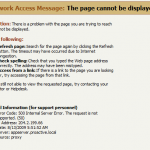 At the office we have a weird Windows 2003 install running the ISA Firewall/Proxy which sits between us and the outside world, for some as yet unknown reason we get brown “Network Access Message: The page cannot be displayed” error messages occasionally when visiting websites (like the example on the right.). I haven’t been able yet to find the cause, but it gets frustrating when some sites are inaccessible for no reason.
At the office we have a weird Windows 2003 install running the ISA Firewall/Proxy which sits between us and the outside world, for some as yet unknown reason we get brown “Network Access Message: The page cannot be displayed” error messages occasionally when visiting websites (like the example on the right.). I haven’t been able yet to find the cause, but it gets frustrating when some sites are inaccessible for no reason.
In order to get trouble free internet I installed a linux machine with a squid proxy, now the problem is that I don’t always want to use the squid proxy as it comes with its own internal network issues on our network.
After a bit of research I found that Google Chrome can be made to use a defined proxy by supplying a command line option. I created a new shortcut for Chrome and set the target too:
“C:\Users\Dale Nunns\AppData\Local\Google\Chrome\Application\chrome.exe” –proxy-server=192.168.0.20:3128
That makes it use my squid proxy (192.168.0.20:3128) when ever its started from that shortcut. Another nice option that I stumbled across awhile ago is to add “-incognito” to the end to start the browser in incognito mode.

 I’m jumping on the current big “band wagon” and going to review the new web browser on the block,
I’m jumping on the current big “band wagon” and going to review the new web browser on the block,